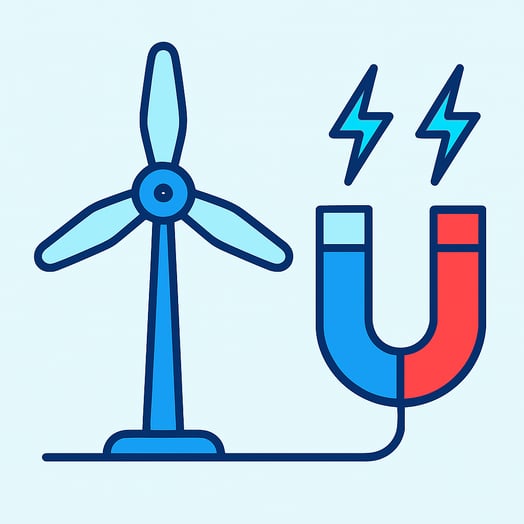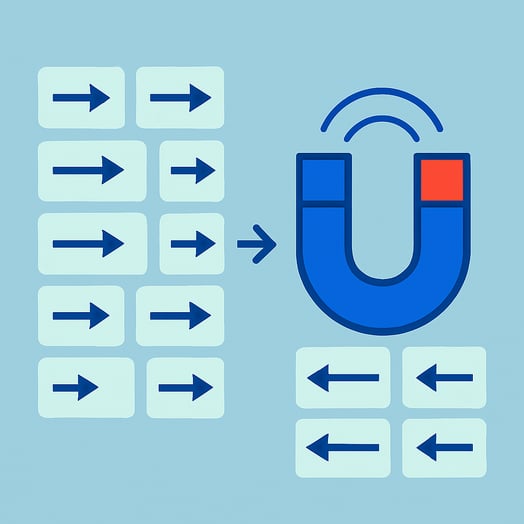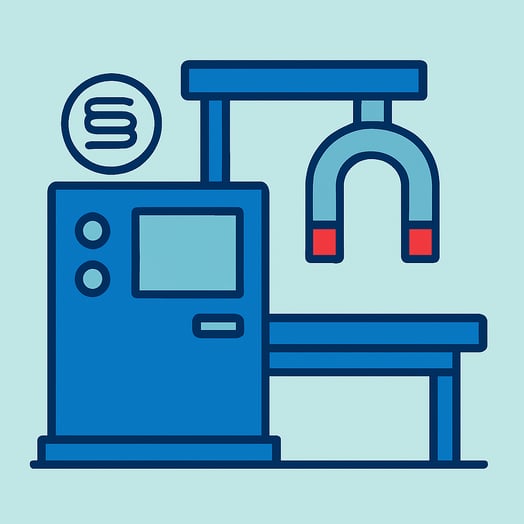Magnetizers energize the high-strength permanent magnets used in direct-drive wind turbine generators. This critical magnetization step ensures maximum energy conversion from wind to electricity, improving the turbine's efficiency, power output, and long-term reliability while reducing maintenance needs.
Wind turbines are towering symbols of renewable energy, but the real magic happens inside the nacelle, where wind's kinetic energy is converted into electricity. In modern, high-efficiency turbines, this conversion relies on an incredibly powerful permanent magnet generator.
But these magnets aren't just powerful by chance. They are engineered to perfection, and the final, most crucial step in that process is magnetization. Let's break down why this step is absolutely essential.
Frequently Asked Questions
Why is magnetization critical for modern wind turbines?
Magnetization is the critical final step that activates the permanent magnets in a direct-drive wind turbine's generator. This process ensures the magnets reach full saturation, which is essential for maximizing the turbine's energy conversion efficiency, power output, and long-term reliability.
What happens if a wind turbine magnet is not fully magnetized?
If a magnet is not fully magnetized to a state known as saturation, it will be weaker. A weaker magnet produces a weaker magnetic field in the generator, which directly translates to lower efficiency and reduced power output from the same amount of wind.
What kind of magnets are used in direct-drive wind turbines?
Modern direct-drive wind turbines utilize high-strength permanent magnets made from rare earth materials, most commonly Neodymium (NdFeB). These are chosen for their ability to produce the incredibly intense and consistent magnetic field required for efficient power generation.
How are the powerful magnets in a wind turbine generator magnetized?
The magnets are magnetized using sophisticated industrial magnetizers that employ capacitive discharge technology. This system delivers a massive, controlled magnetic field pulse of 3 to 5 Tesla through a custom-engineered fixture, ensuring the magnets are fully and uniformly saturated. Magnets are pre-magnetized and assembled onto the rotor. There's no pattern to consider in this magnetizing process.
The Heart of the Turbine: The Permanent Magnet Generator

Many of the most advanced wind turbines today use a "direct-drive" system. Unlike alternate designs that use a complex, maintenance-heavy gearbox, a direct-drive turbine connects the rotor blades directly to a permanent magnet generator.
This design is simpler, more reliable, and more efficient. However, its performance hinges mainly on the strength and stability of its magnets. These generators contain rare earth magnets—typically Neodymium (NdFeB)—which must produce an incredibly intense and consistent magnetic field to generate electricity effectively.
The Critical Role of the Magnetization Process

A raw, unmagnetized Neodymium magnet is essentially inert. The magnetization process "activates" it, aligning its internal structure to unleash its full magnetic potential. For a wind turbine, getting this step right is non-negotiable for several key reasons.
Achieving Maximum Magnetic Saturation
Rare earth magnets have high "coercivity," meaning they strongly resist changes to their magnetic state. To magnetize them fully—a state known as saturation—requires an immense blast of magnetic energy, often between 3 to 5 Tesla.
Failing to reach full saturation results in a weaker magnet. A weaker magnet in a generator produces a weaker magnetic field, which directly translates to lower efficiency and power output from the same amount of wind. Industrial Magnetizers are specifically designed to deliver these high-intensity energy pulses, ensuring every magnet performs at its peak theoretical strength.
Ensuring Peak Generator Efficiency
The efficiency of a permanent magnet generator is directly proportional to the strength of its magnetic field. By using a precisely controlled magnetization process, manufacturers can guarantee that the magnets meet the exact performance specifications required for optimal energy conversion.
This precision ensures the turbine generates the maximum possible power from low and high wind speeds, increasing its overall annual energy production and financial return.
Enhancing Durability and Reducing Maintenance
Direct-drive turbines are built to operate for over 20 years in harsh conditions with minimal intervention. The permanent magnets must maintain their strength for the entire lifespan of the turbine.
A properly magnetized magnet is more stable and less prone to demagnetization over time. The industrial-grade process used by specialized Magnetizers ensures a deep, uniform magnetization that enhances the magnet’s long-term stability, contributing to the turbine’s "set it and forget it" reliability.
How Industrial Magnetizers Get the Job Done

Wind turbine generators' rotors are not magnetized post-assembly. They are assembled with pre-magnetized magnets. It requires a sophisticated system engineered for power, precision, and production-line integration.
-
Capacitive Discharge Technology: To generate the required 3-5 Tesla field, advanced magnetizers use a capacitive discharge system. This technology stores a massive amount of electrical energy and releases it in a single, controlled, high-current pulse, creating the intense magnetic field needed to saturate high-coercivity Neodymium magnets.
-
Custom Magnetizing Fixtures: A turbine’s generator rotor is a large, complex component that uses magnets arranged in a specific multi‑pole pattern. Because the magnets are large and must meet tight performance requirements, they are magnetized before being installed on the rotor. This magnetization is done using custom‑engineered fixtures that apply a strong, precisely controlled magnetic field. These fixtures ensure each magnet is magnetized uniformly and with the correct polarity pattern so that, once mounted on the rotor, the generator operates as designed.
-
PLC-Controlled Integration: In a manufacturing environment, the magnetization process must be repeatable, safe, and efficient. Magnetizers designed for industrial use are PLC-controlled (Programmable Logic Controller), enabling seamless integration into an automated production line.
The Bottom Line: Better Magnetization, Better Renewable Energy
In the world of renewable energy, efficiency and reliability are everything. The magnetization process is not just a final touch; it is the fundamental step that unlocks the performance of a critical component in a modern wind turbine.
By ensuring every magnet in the generator is fully and precisely saturated, specialized systems like industrial magnetizers directly contribute to producing more clean energy, improving the reliability of our power grid, and accelerating our transition to a sustainable future.


